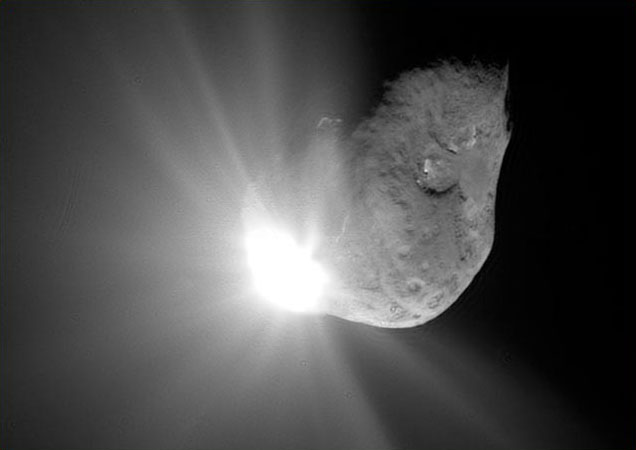|

by Wallace Thornhill
Feb 14, 2006
from
Thunderbolts Website

Credit:
NASA/JPL-Caltech/UMD
Early in the morning of July 4, 2005,
cosmic fireworks occurred millions of miles from Earth. NASA had
planned the event to clear up some longstanding mysteries about
comets. But what actually happened defied every expectation of the
comet experts.
About 24 hours earlier, the Deep Impact spacecraft had fired an
800-pound copper projectile at the nucleus of Comet Tempel 1. The
impact was expected to eject large volumes of subsurface material
into space, and we were assured that the material would be dominated
by water. The presence of abundant volatiles, preeminently water ice
sublimating in the heat of the Sun, is an essential requirement of
standard comet theory.
Without cometary ices, it is the “dirty snowball” theory that would
evaporate. How could comets produce their often-spectacular tails in
the absence of sublimating volatiles?
Cameras on the projectile recorded its approach toward the nucleus,
and instruments on the spacecraft observed the event across a broad
spectrum. Dozens of telescopes on Earth and in orbit around the
Earth were trained on the comet.
According to NASA scientists, the released material would provide a
sample of the primordial water, gas, and dust from which the Sun,
planets, moons, and other bodies in the solar system formed.
Statements advancing this claim were the general rule, as if the
modern theory of comets was no longer a theory, but a fact.
So proponents of the Electric Universe predicted a “shock to the
system”. They believe that a comet carries a negative electric
charge as it moves through the extensive and constant radial
electric field of the positively charged Sun. The nucleus acquires
this negative charge during its long sojourn in the outer solar
system. Then, as it speeds into the inner solar system, the
increasing voltage and charge density of the ambient plasma (solar
“wind”) causes the nucleus to discharge electrically, producing the
bright coma and tail.
The electric model does not exclude the
possibility of water on a comet nucleus, but water is not required,
and the electrical theorists say we will inevitably find more than
one comet discharging energetically but with no water present at
all. This lack of need for volatiles is supported by the occasional
outbursts from comets in "deep freeze" beyond Saturn.
Following pointers from Wallace Thornhill, the leading proponent of
the electric comet model, the Thunderbolts crew registered a series
of predictions for Deep Impact on July 3, the most specific and
detailed scientific predictions offered by any group in anticipation
of the event.
On the matter of water, we stated:
“An abundance of water on or below the surface of the nucleus (the
underlying assumption of the “dirty snowball” hypothesis) is
unlikely”. Though this was never a deal killer for the electric
model, the absence of sufficient water in a comet is a deal killer
for the dirty snowball model. We wrote: “In fact none of the
electrical theorists will be surprised if the impactor exposes a
subsurface with little or no ices”.
Almost immediately after Deep Impact it was clear that the event had
not produced the watery outburst NASA had expected. In a July 8
press release, the Harvard-Smithsonian Center for Astrophysics
summarized the early findings with the headline,
"Deep Impact Was a
Dust-up, Not a Gusher".
Smithsonian astronomers had monitored the impact using the
ground-based Submillimeter Array (SMA) in Hawaii and NASA's orbiting
Submillimeter Wave Astronomy Satellite (SWAS). Early reports showed
“only weak emission from water vapor and a host of other gases that
were expected to erupt from the impact site. The most conspicuous
feature of the blast was brightening due to sunlight scattered by
the ejected dust” [emphasis ours].
This was not what they had
expected by any means.
"It's pretty clear that this event did not produce a gusher," said
SWAS principal investigator Gary Melnick of the Harvard-Smithsonian
Center for Astrophysics (CfA). "The more optimistic predictions for
water output from the impact haven't materialized, at least not
yet."
The Deep Impact team had hoped that, by excavating material from the
comet's interior, they could find the one thing the standard model
required.
“SWAS operators were puzzled by the lack of increased
water vapor from Tempel 1”.
In fact, an observation from the Odin
telescope in Sweden found that the relative abundance of water
decreased after the impact, due to the injection of quantities of
dry dust, not water.
Astronomer Charlie Qi (CfA) also expressed surprise at these
results.
"Theories about the volatile layers below the surface of
short-period comets are going to have to be revised," Qi said.
So
the crisis for standard comet theory deepened. Advocates of the
dirty snowball model had already been forced into an untenable
position by prior discoveries of dry comet surfaces. But as best we
can tell, until very recently there had been no public
acknowledgment by NASA that none of the prior comet visits (Halley, Borrelly, Wild 2) had revealed surface water! (See below)
It is easy to understand why astronomers began to speculate about
water buried beneath layers of surface material. But if an 800 pound
projectile meeting a comet at 23,000 miles per hour, could not
release the “subsurface water” demanded by theory, how could mere
sunlight in the deep freeze of space do the job?
Qi speculated that the comet might become more active over the
following days and weeks.
“We're still hoping for a big outgassing
from the new active area created by Deep Impact”, he said.
The
electrical theorists predicted it would not happen, and it didn’t.
In fact comets have a history of dashing comet investigators’ hopes
for finding water. Periodic and unpredictable outbursts from comet
nuclei are common, but emissions suggesting hidden water or other
volatiles beneath the surface have not occurred. The general rule
is: when cometary outbursts occur, as happened more than once with
Comet Tempel 1 prior to “Deep Impact, the immediate effect is that
relative levels of water in the coma go down.
One other possibility for saving the snowball theory of comets was
to observe the fragments of comets that have disintegrated. When
comet Shoemaker-Levy-9 broke apart, astronomers reasoned that the
fractured nucleus would expose fresh ices that would sublimate
furiously. So several ground-based telescopes and the Hubble Space
Telescope trained their spectroscopes on the tails of the fragments
of SL-9, looking for traces of volatile gases. None of the gases
were found. When Comet Linear disintegrated in front of their eyes,
astronomers were not just shocked by the event (a comet exploding
many millions of miles from the Sun), they were astonished to find
virtually no water in the immediate debris.
For several months after “Deep Impact”, we awaited NASA’s
publication of official results, confident that the investigators
would place a priority to the issue of available water on the comet.
And in a sense, they did.
On February 2, 2006, the official Deep
Impact site, posted the headline, “Deep Impact Finds Water Ice on
Comet”, with the following lead-in to the story:
“ Scientists on NASA's Deep Impact mission report the direct
detection of solid water ice deposits on the surface of comet Tempel
1. This is the first time ice has been detected on the nucleus, or
solid body, of a comet”.
News outlets around the world dutifully ran the story, and unless
readers were prepared to dig deeper, they would be left with the
impression that everything is fine with comet theory these days.
But all is not well with comet theory. The interpretation that led
to the identification of surface water on Tempel 1 may be entirely
reasonable, but if you grant the interpretation you are left with a
horrendous shortage of available surface water. As reported in the
journal New Scientist, the water ice “is present in surprisingly
small amounts”.
By all accounts, the surface of Tempel 1 presented
no better than 0.5 percent of the icy surface needed to account for
the supposed watery output of Tempel. (The exceedingly small and
thin “icy” areas were about 94 percent dirt).
Jessica Sunshine of Science Applications International Corporation,
the lead author of a recent article in the journal Science,
announced the investigator’s finding: "These results show that there
is ice on the surface, but not very much and definitely not enough
to account for the water we see in the out-gassed material that is
in the coma”.
Objectively, the NASA team’s findings confirm the failure of a
theory. But somehow that critical failure did not make the
headlines, due to the confidence of the theorists that the required
water must be there, but hidden under the surface. So instead of
questioning the theory, the investigators are now asking themselves
how ice could stay hidden while feeding Comet Tempel’s “watery”
output, which they calculated to be about 555 pounds per second!
It is the wrong question and it can only extend a dead end path a
while longer.
To see this dead end path for what it is, we must ask
the question that has not been asked:
What is the source of the
“water” in the comas of comets?
|

